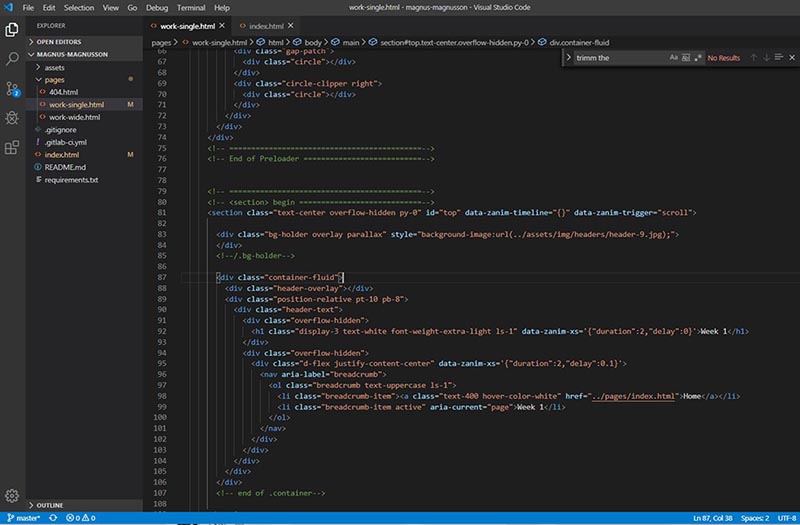Week 1
Principles and Practices
Week 1 - Assignments
• Setting up a website that is hosted on GitLab
• Upload it to the class archive.
• Work through a git tutorial.
GitLab is a web-based DevOps lifecycle tool that provides a Git-repository manager providing wiki, issue-tracking and CI/CD pipeline[7] features, using an open-source license. https://about.gitlab.com/) command line utilities that track and record changes in files
To Communicatie with Gitlab i Intalled Gitbash – Git for windows provides a Bash emulation to run Git from the command line.
https://gitforwindows.org
To connect my computer to Gitlab i ran a series of commands from the tutorial on Fabacademy Site
1. To ad my git user name and email
git config –-global user.name “YOUR_USERNAME”
2. Configure my email adress for uploading
git config -–global user.email “jSmith@mail.com”
1. Check if you have an SSH KEY already
cat ~/.ssh/id_rsa.pub ”
2. Generate your SSH key
ssh-keygen -t rsa -C "$your_email”
Copy your key to GIT on the web version.
Windows: clip < ~/.ssh/id_rsa.pub Mac:pbcopy < ~/.ssh/id_rsa.pub Linux xclip -sel clip < ~/.ssh/id_rsa.pub”
When the SSH key is uploaded to Gitlab you can push your files to the server

To edit the code i used Visual Studio Code. It is a lightweight but powerful source code editor which runs on your desktop and is available for Windows, macOS and Linux. It comes with built-in support for JavaScript, TypeScript and Node.js and has a rich ecosystem of extensions for other languages (such as C++, C#, Java, Python, PHP, Go) and runtimes (such as .NET and Unity).

Final Project




The portable water turbine
I have a little fishing hut by a river in a rural part of south Iceland. This hut is quite primitive with no running water and almost no electricity. When I say almost, its because I have solar cells on the rooftop to engine a few lights to help over the darkest hour. As for other equipment, I have a gas stove to cook and a gas heater to keep warm and prevent the hut from molding. Some might say that this hut is to primitive to use but for me its quite the opposite. Sometimes the only therapy you need is to get away from the hectic everyday life and experience the peace and quiet, and that is what I get in my hut.
That said, of course here are some aspect of my hut that I would like to adjust. The solar cell for example does not function as it could due to scars sunlight in the winter time in Iceland. That, combined with the long dark days, makes it hard to rely on solely.
Like I said before, the hut is situated by a river. In Iceland we have a long history of harvesting rivers and streams for electricity. Iceland gets about 71% of its electricity this way and another 22% from geothermal harvesting. These facts are part of the Icelandic culture and shape the way we think about our nature. Therefore, it was a natural step to try to harvest the river by my hut to make my own electricity with some kind of a water turbine.
But I didn’t want to stop there. As much as I love my hut, I also enjoy traveling through the wilderness of Iceland, by cars, horses and on my feet. And as much as I enjoy the peace and quiet, I also know that the weather in Iceland can change rapidly and you should always have a fully charged phone or an emergency locator of any kind. This, as well as the fact that the Icelandic wilderness is full of rivers and water streams got me to the idea to find a way to make a small, portable water turbine, efficient enough to charge a phone, a radio or similar.
ABOUT ME As a trained pilot and graphic designer working for a furniture manufacturer, I have always been fascinated by how things work. I am a craftsman by nature and have a deep need to understand “the material” and its capacity. Being married for over twenty years, a father to three kids and living in the countryside has also been the theme for most of my adult life, making me inclined to always try to find practical ways to better my surrounding for the benefit of the whole. My Fab Academy project regarding a portable water turbine originates from these elements and will hopefully benefit others as well.Final project
| Developer: | Magnus St. Magnusson |
| Category: | Electric generating device |
| Skill: | Electric, 3d design, 3d printing, CNC mill |
| Date Post: | 04 February, 2020 |
| Tags: | Electric Turbine, Electric generation |
Magnús St. Magnússon © 2020| v1
Madefor FabAcademy